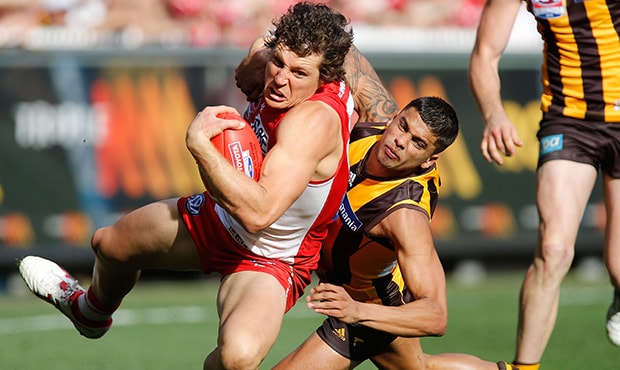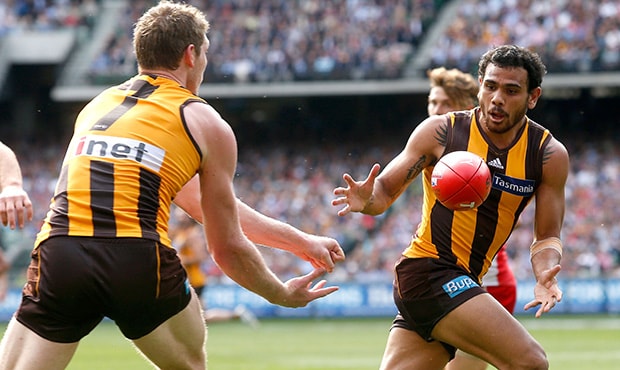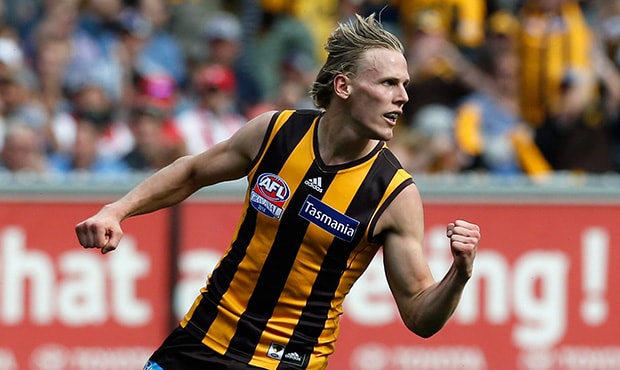After Hawthorn’s 63-point Grand Final win over Sydney Swans, hawthornfc.com.au looks at the five main points to take out of the game.
1. Hawk immortals
Hawthorn players wrote themselves into the history books on Saturday, winning back-to-back flags for just the second time in the Club’s history.
It is a remarkable achievement to win back-to-back flags but to do it under the circumstances Hawthorn did this year is to be commended.
It’s not every day a coach must leave his post mid-season as Alastair Clarkson did from Rounds 11-15 before resuming in Round 16 after battling Guillian-Barre Syndrome.
The resilience of the players and coaches is tremendous as the leadership that is evident from skipper Luke Hodge and leaders like Jordan Lewis and Jarryd Roughead should be commended for the way they handled the challenges of this season.
The Grand Final win was Hawthorn’s 50th victory in a final and the Club’s third Grand Final win in four attempts since 2008.
2. How the Hawks won it
Not many gave Hawthorn a chance against Sydney, the Swans the overwhelming favourites with the bookies and with commentators.
The underestimated the Hawthorn spirit and the relentless drive to success.
Hawthorn’s pressure was something to behold, laying bone-crunching tackles that left Sydney players shell-shocked and hurt from the opening bounce. There were at least three or four instances in the opening quarter alone that Swans players required medical attention after a hard tackle from a Hawthorn player.
The Hawks ended the game with 63 tackles to 57 – a stunning effort given they had 144 more possessions than the Swans (442-298) but it was the inferred pressure too, that brought the Swans undone.
Then, it was the dominance of the midfield that rammed home the advantage, particularly in the opening half when the Hawks set up the win.
Hawthorn had the first eight clearances of the second term and piled on five goals to one (those five came in succession in nine minutes) to lead by 47 points.
At half time Hawthorn had 47 more disposals (207-160), 20 more inside 50s (35-15), eight more clearances (22-14) and laid 32 tackles to 24 – it was a complete domination.
Skipper Luke Hodge kicked two successive goals in the second term to ram home the advantage as the Hawks forwards feasted on the outstanding job the likes of Hodge (35 disposals, two goals), Sam Mitchell (33, seven clearances) and Jordan Lewis (37, seven clearances) in the midfield.

Hawthorn's pressure was fierce and the tackling brutal as Bradley Hill brings down the 100+kg Kurt Tippett.
3. The inspired selections of Rioli, McEvoy
Cyril Rioli might not have kicked five goals like teammate Jarryd Roughead or had 37 disposals like Lewis but his impact on Saturday was profound.
Skipper Hodge said after the Grand Final Parade that Rioli’s importance to Hawthorn is in his defensive pressure and that proved true in the Grand Final.
While the stats sheet says he laid just two tackles and had a modest nine disposals, it was his hard running to chase opposition players to force turnovers and his ability to get a hand in and stop a handball or smother a kick or even cuase a stoppage by diving on the ball was outstanding.
He set up a goal to teammate Roughead in the third term by smothering a Kurt Tippett handpass on half-back then grabbing the footy and moving it quickly.
His selection by Coach Alastair Clarkson was inspired as was that of Ben McEvoy.
Jonathon Ceglar was stiff to miss out no doubt but McEvoy ran Mike Pyke ragged on Saturday.
Although he finished with just 14 hit outs, McEvoy’s strength is in his running capacity and ability to almost act as another midfielder around the ground.
He had 15 disposals and used the ball at 93.3 per cent efficiency, took five marks, laid three tackles and even had four one percenters.
McEvoy played his role and contributed significantly to the win.

Hawthorn's two inclusions combine to generate more run for the Hawks.
4. Langford makes his mark
While some expected Will Langford to play a handful of games this year, there were probably little who thought he’d play in a premiership and not only that, be a significant contributor.
But the young Hawk proved a significant piece of the premiership puzzle, with his tenacity, speed and killer instinct making him one of Hawthorn’s best throughout the last two months of the year.
His performances in the finals series and particularly on the biggest stage of all in the Grand Final underlined his status as one of the young guns of the competition.
Langford finished with 21 disposals, six tackles, six inside 50s and three goals in one of the stunning Grand Final performances by a young player.
He has well and truly now stepped out of the shadow of his dad, Hawks great Chris, and make his mark on both the Hawks and the league as one of the best young talents.

Will Langford celebrates one of his three rather spectacular goals.
5. Gibson and Lake do it again
Hawthorn’s midfield stole the show on Saturday but we haven’t forgotten the heroics of dual premiership defensive duo Josh Gibson and Brian Lake.
One year after taking down Fremantle’s forward line, the duo did it again on the bog stage but this time against prized Swans forwards Lance Franklin and Kurt Tippett.
Franklin was the best of the Swans forwards but worked hard for his four goals, with a number of another attacks on the footy thwarted by former teammates Gibson and Lake.
Then there was Tippett who had little to no impact on the contest.
Their defensive work was outstanding, particularly in the one-on-ones and then when coming across to help their teammates. They finished with seven (Lake) and six (Gibson) one percenters each.
Then there was Gibson’s work as a rebounder off half-back, finishing with an incredible 32 disposals, six marks and six rebounds 50s, while Lake finished with 20 disposals, seven marks and three tackles.
Both were relentless in their desire to stop the Sydney forwards and their respective performances were indicative of the attitude and play of Hawthorn in the Grand Final win.


